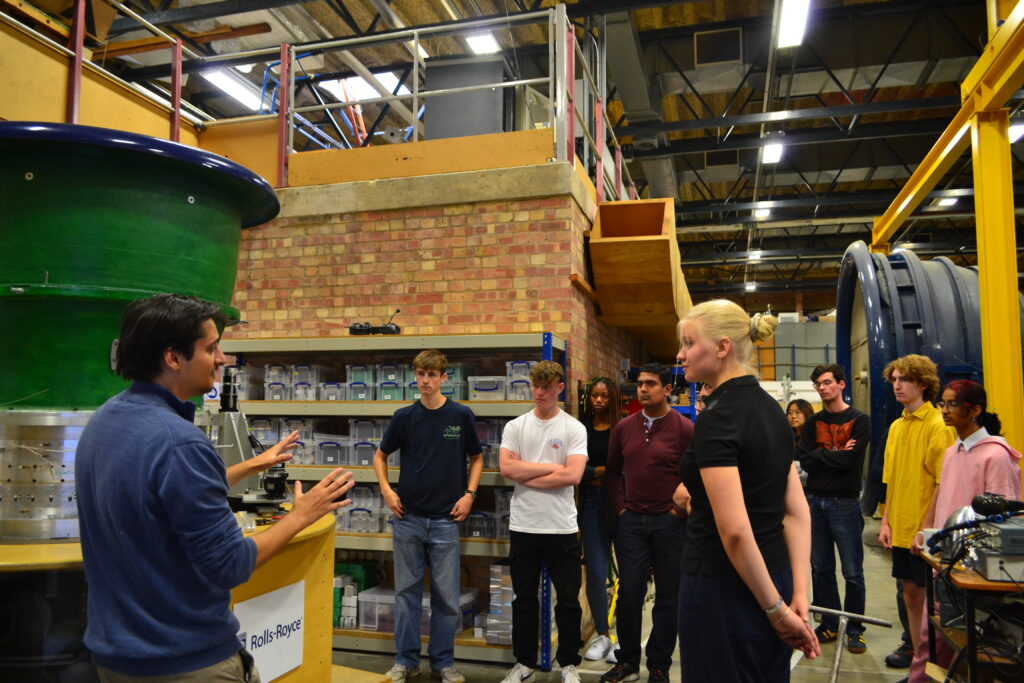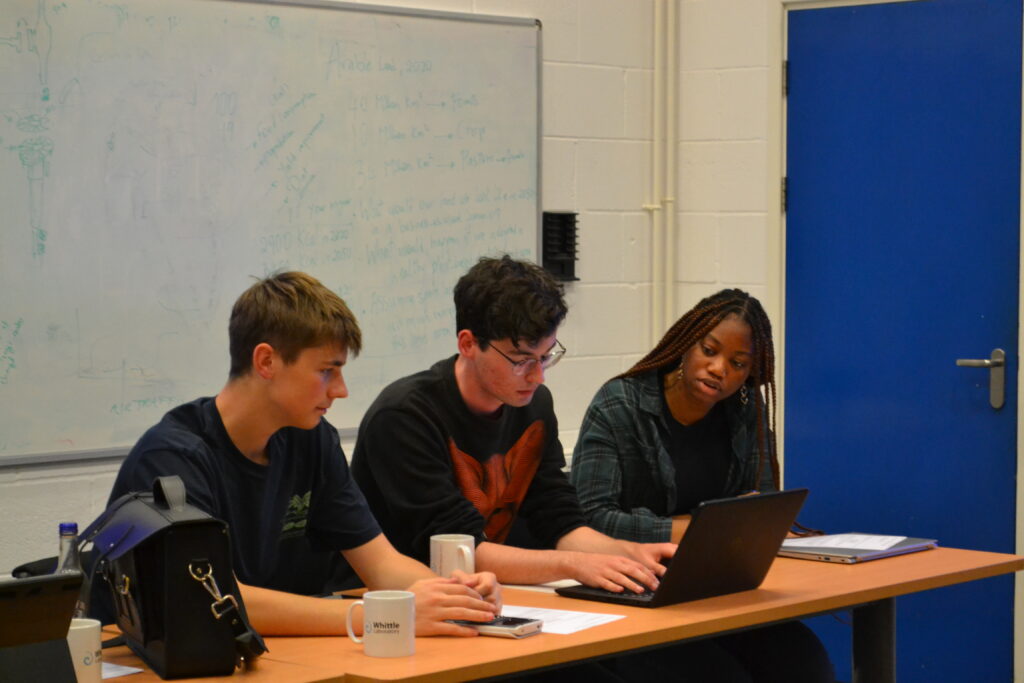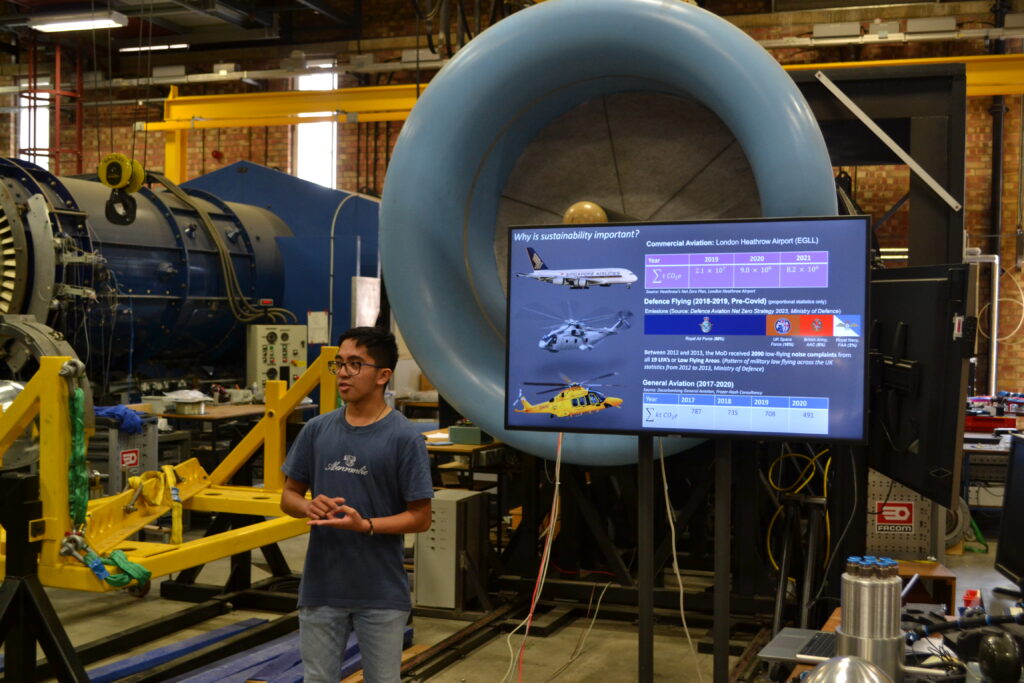In August-September 2023, the AIA hosted a summer work experience week to introduce local sixth form students to the multidisciplinary work of the Aviation Impact Accelerator.
Some of the students decided to write some reflections on their experience below, highlighting the activities they did including a research project on biomass availability in the UK.

Emmi Blackburn
During the first day of our work experience at the Whittle Laboratory, we were given a comprehensive tour of the Whittle Lab, where we explored high-speed and low-speed labs and witnessed the cutting-edge research and technology in aerodynamics hosted there. One of the highlights of the tour was visiting the high-speed wind tunnels to observe aerodynamic testing equipment and discuss optimal wing shapes and the importance of maintaining a low Reynolds Number to minimise drag from turbulent airflow.
However, the most captivating part of our day was witnessing the boundary layer ingesting test rig in action. It was a remarkable experience to observe the engine testing and to participate in pressure boundary testing to determine at what point an engine might stall during flight. Prior to our visit to the Whittle Laboratory, we were tasked with preparing a short presentation that introduced ourselves and our interests in sustainability. We also had the opportunity to discuss a topic related to aviation that we found interesting.
Our presentations covered a wide range of exciting topics. For instance, how contrails can impact jet engine performance and exploring emerging technologies that enable aircraft to maintain optimal oxygen levels for longer durations, enabling more direct flight paths.
Furthermore, we shared our thoughts on the future of sustainable aviation. We contemplated how advances in aerodynamics research could revolutionise fuselage design to accommodate larger masses while simultaneously reducing the drag generated during flight. We also discussed the ongoing shift towards Sustainable Aviation Fuels (SAF) and the potential of alternative fuel technologies such as hydrogen and electricity in making aviation more environmentally friendly and sustainable.
Alex Mawhinney
Following our tour of the Lab and our initial presentations, we proceeded to explore first order modelling. This method employs less precise numbers and relatively simple calculations that can be executed with knowledge of A-Level Mathematics to draw meaningful conclusions. We were provided with data on arable land use from the World Bank. Based on assumptions that average calorie intake and crop yield would increase, we developed projections for how this land will be used by 2050. These projections were divided into two scenarios: a business-as-usual scenario (BAU), and a hypothetical scenario where the entire global population consumed a healthy plant-based diet.
In the BAU scenario, our calculation showed that sustaining the projected global food intake of 2050 would require the deforestation of a substantial amount of land. Predictably, the overwhelming majority of this extra land demand was attributed to pastures.
Under the plant-based diet scenario, the 34 million square kilometres of land currently used for pastures would no longer be required. Assuming that 30% of our calories come from animal-based produce, we would need additional land for crops. However, given that the land for pastures would not be used for food production, there would be substantially less land used for food under the plant-based diet scenario when compared to the BAU scenario.
These conclusions surprised us all, and on a personal level it certainly made me more conscious of my consumption of animal-based produce. I found it intriguing how such rough numbers and some quick calculations can give us a myriad of useful information that can be acted upon.
Relating our work back to aviation, we then looked into what we could do with this excess land under the plant-based diet scenario. Using existing techniques to extract energy from crops, we found that there is significant potential for harvesting energy which could be used in producing Sustainable Aviation Fuels.
Following on from this, we were given a talk on how we can utilize these skills to draw other useful conclusions. For instance, we considered a hypothetical magical scooter, which takes the shortest route wherever it goes and reaches its destination as quickly as possible. However, given that humans can only comfortably withstand 1G of acceleration it can be concluded that the fastest time to get to the other side of the world is around 45 minutes. It would take approximately 3.5 days to get to Mars, making the prospect of intergalactic holidays unfeasible for the foreseeable future. Again, this demonstrates the sheer power of some simple, yet directed and purposeful calculations.

Aditya Iyer
On Days 2 and 3, we saw a change of location for all of us. While working remotely, the AIA presented us with the challenge of analysing the effects and pitfalls of global waste management policies. Our primary source of data was a World Bank database which contained data on waste production and treatment. From this we were required had to answer questions on existing waste management policies and whether they work, what proportion of waste is already being converted into useful products and how much more energy we could generate from waste that is not sustainably managed.
However, from the outset, all of us faced a major problem. The dataset itself was incomplete, consisting of a multitude of null or missing values and as a result we were tasked with figuring out how to work around it. Lack of data availability is an issue that Engineers deal with and overcoming this in this work experience was a challenge. The prevailing general consensus was that this source alone could not be the only way to justify any conclusions we made. As a result, most of us opted for a more research-based approach, categorising countries, and researching why outliers existed within the data. The rest of us looked at a more mathematical way of creating statistics with the available data to analyse how sustainably countries were managing waste. Having completed the main part of the task we were asked to culminate our findings into presentations to the rest of the group.

Lorenzo Reserva
For the final day, we returned to the Lab to present our analysis which we had worked on for the past two days. Initially, we were given some short presentations which introduced the team from the AIA who all had broad backgrounds from being involved in the United Nations to a Chemical Engineering professor at Cambridge to an Officer Cadet preparing to start Initial Officer Training at Royal Air Force College Cranwell before progressing into RAF Engineering.
All the presentations allowed us to get an insight into the various career opportunities as well as some insight into life at Cambridge like the University Air Squadron. After this, we began to present – some presented alone whilst some opted to remain in groups. Results yielded varied as people applied various techniques like mathematics and statistics, computational methods as well as political, legal and some sociological considerations being used to justify analysis and reasoning. After each presentation, everyone was given feedback on their presentations, which was important as they help develop such skills whether for academia or in employment.
At the end, we were able to discuss our time at the Whittle Laboratory and give some verbal feedback before saying goodbye to everyone. Although presentation skills and first order analysis were the main learning objectives, one of the most important aspects which was very integral to this work experience was the opportunity to meet and work with a very diverse range of people from the staff who work at Whittle to the actual students themselves. They all have different ways of doing things and thinking and getting to know and socialise with them is one of the most rewarding parts of the placement.
This work experience provided a holistic learning experience, combining technical knowledge with real-world applications and considerations. The opportunity to learn, interact, and reflect provided by the AIA work experience week seems to have been profoundly impactful for all participants equipping them with insights and skills beneficial for their future academic and professional endeavours.